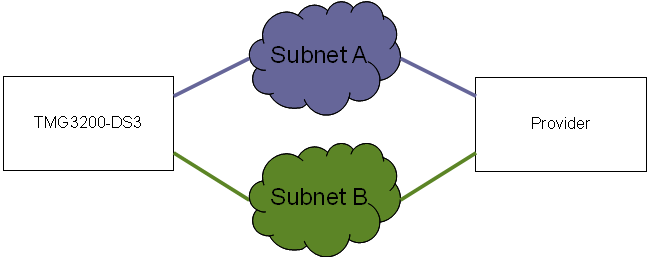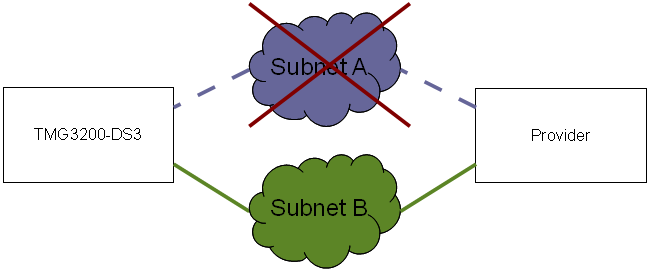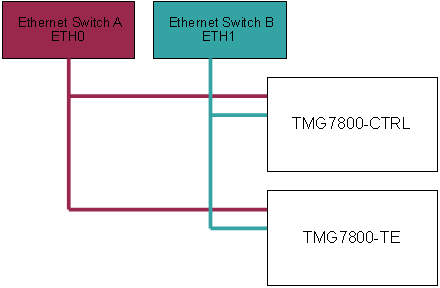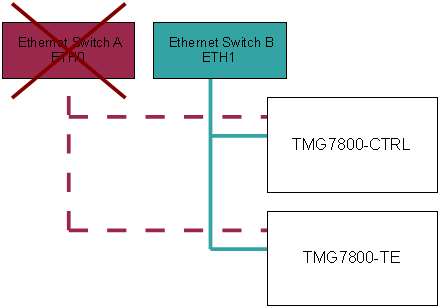Redundancy & High Availability:Network
(add control network details) |
m (add more details) |
||
| Line 21: | Line 21: | ||
A different subnet is required for each VoIP interface. The obvious use of the 2 VoIP ports is to connect one port with a private network and the other to the public network. A second application of the 2 VoIP ports are to connect to your providers using 2 different networks. | A different subnet is required for each VoIP interface. The obvious use of the 2 VoIP ports is to connect one port with a private network and the other to the public network. A second application of the 2 VoIP ports are to connect to your providers using 2 different networks. | ||
| − | Here is an example | + | Here is an example of VoIP network redundancy with a [[TMG3200]] |
[[Image:Ha_2_Voip_Networks.png|TMG3200 VoIP Network Redundancy]] | [[Image:Ha_2_Voip_Networks.png|TMG3200 VoIP Network Redundancy]] | ||
| Line 34: | Line 34: | ||
The Control network is only available for the [[TMG7800]] model. The control network allows the [[TMG-CONTROL]] to manage the [[TMG7800]] Telecom units. Each TMG7800 units contains 2 control network interfaces labeled ETH0 and ETH1 respectively. The control network should be on private subnets to avoid lost of packets between the [[TMG7800]] units. Which is why TelcoBridges recommends the use of 2 Ethernet switches one for interfaces. | The Control network is only available for the [[TMG7800]] model. The control network allows the [[TMG-CONTROL]] to manage the [[TMG7800]] Telecom units. Each TMG7800 units contains 2 control network interfaces labeled ETH0 and ETH1 respectively. The control network should be on private subnets to avoid lost of packets between the [[TMG7800]] units. Which is why TelcoBridges recommends the use of 2 Ethernet switches one for interfaces. | ||
| − | Here is an example | + | Here is an example of the TMG7800 control network. |
[[Image:Ha_Control_Network.png|TMG7800 Control Network]] | [[Image:Ha_Control_Network.png|TMG7800 Control Network]] | ||
Revision as of 16:30, 8 February 2011
Networking is a critical section of the system that is sometimes overlooked. An adequate network will avoid problems like congestion or disconnection.
Contents |
Network Redundancy
TelcoBriges recommends the use of 2 Gigabytes Ethernet Switches for a Tmedia system.
TMG800/TMG3200 example
TMG800/TMG3200 Redundancy Switch Setup
TMG7800 example
TMG7800 Redundancy Switch Setup
VoIP Network
The VoIP network are secured interfaces that are use to send signaling and data packets over Ip networks (i.e. Sip, Sigtran, RTP). They are considered secured because it is not possible to control the Tmedia through those interfaces. TelcoBridges provides 2 VoIP ports on all its VoIP Gateway models.
A different subnet is required for each VoIP interface. The obvious use of the 2 VoIP ports is to connect one port with a private network and the other to the public network. A second application of the 2 VoIP ports are to connect to your providers using 2 different networks.
Here is an example of VoIP network redundancy with a TMG3200
If one of the network is down (because of a switch or cable malfunction), the other network can still reach the providers as seen in the next example
Control Network
The Control network is only available for the TMG7800 model. The control network allows the TMG-CONTROL to manage the TMG7800 Telecom units. Each TMG7800 units contains 2 control network interfaces labeled ETH0 and ETH1 respectively. The control network should be on private subnets to avoid lost of packets between the TMG7800 units. Which is why TelcoBridges recommends the use of 2 Ethernet switches one for interfaces.
Here is an example of the TMG7800 control network.
As shown in the next example, the system remains operational even if there is a network failure
TMS Network
The TMS network is only available for the TMG7800 model.



